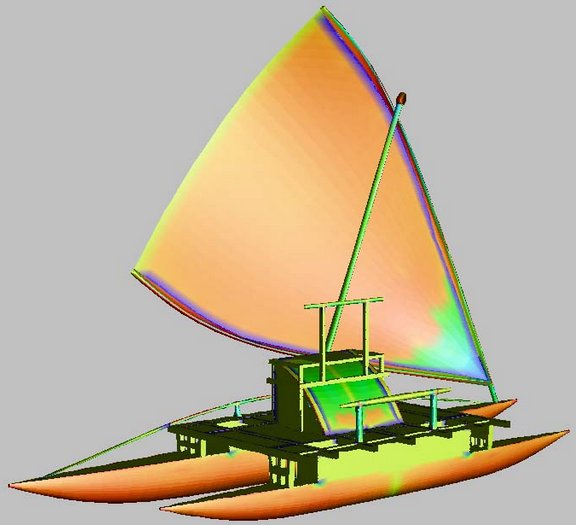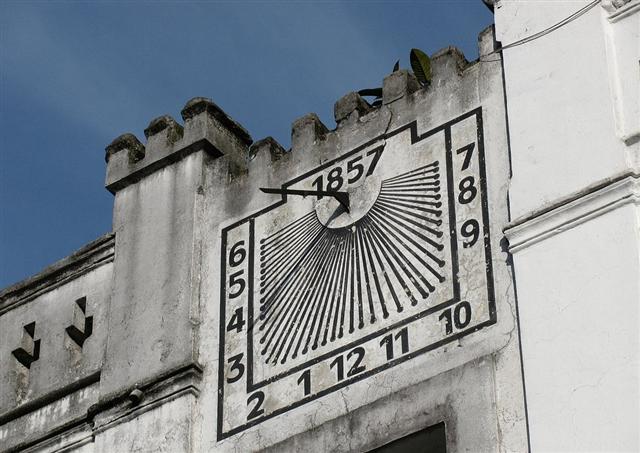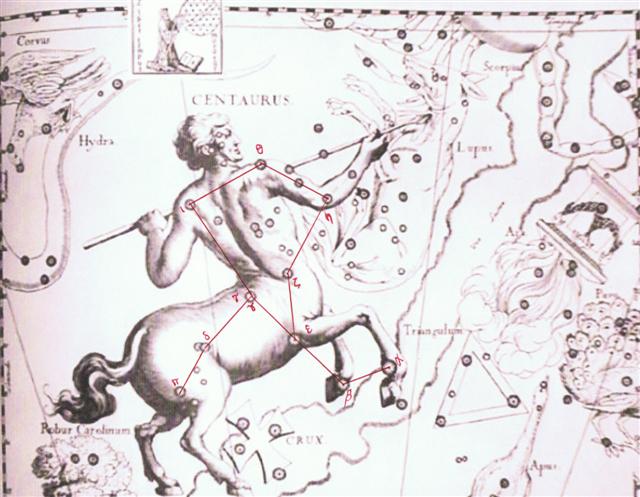My dilemma as a reader of the G text, viz. how to plait together the stars with the glyphs when there were 471 glyphs but only 365 days in a year, could possibly be solved by reading in Manuscript E how the canoes of the King and the Queen were no longer lashed together from the point when they arrived to Te Taanga: ... On the fifteenth day of the month of October (tangaroa uri), Nonoma left the house during the night to urinate outside. At this point Ira called out to Nonoma, 'Look at the canoe!' Nonoma ran, he quickly went to Te Hikinga Heru (a ravine in the side of the crater Rano Kau) and looked around. There he saw the double canoe way out near the (offshore) islets, and the two (hulls of the canoe) were lashed together. He ran and returned to the front of the house. He arrived and called into the house: 'Hey you! This canoe has arrived during the night without our noticing it!' Ira asked Nonoma, 'Where is the canoe, which you say is lying out there (in the water)?' Nonoma's voice came back: 'It is out there (in the water) close to the (offshore) islets! There it lies, and the two (hulls) are lashed together.' ... The ones on board the boat saw Raparenga's waving and understood. The signals arrived on board the canoe; the waving arrived below (i.e., in the west). The two hulls were no longer kept lashed together (i.e., they were separated for the rest of the journey). Hotu called out to the canoe of the queen: 'Steer the canoe to the left side when you sail in. Teke will jump over on board (your) canoe to work his mana when you sail through the fishing grounds!' Teke jumped on board the second canoe, (that) of the queen. The king's canoe sailed to the right, the queen's to the left ...
The canoe of Ava Rei Pua went clockwise around the island and the canoe of Hotu went in the opposite direction - against the clock.
Out in the front of bay of Hanga Rau the pair of canoes anchored without having been joined together again: ... After Hotu's canoe had anchored, the child of Vakai and Hotu appeared. It was Tuu Maheke, son of Hotu, a boy. After the canoe of Ava Rei Pua had also arrived and anchored, the child of Ava Rei Pua was born. It was a girl named Ava Rei Pua Poki ... Possibly it meant the previous lunar calendar ('canoe') had to be stopped because the First Point of Aries was no longer at 0h. Aries had moved ahead, i.e. the Sun could no longer keep pace with it and he would arrive at 0h when Aries already had left. ... The men on board the royal canoe looked out from Varinga Te Toremo (the northeastern cape of the Poike peninsula). Then they saw the canoe of the queen, the canoe of Ava Rei Pua, as it reached Papa Te Kena (on the northern shore, east of Hanga Oteo). Honga came and gazed in the direction below (i.e., toward the west). He called out to the noteworthy ruler (? ariki motongi) Hotu: 'There is the canoe of the queen! It will be the first one to land!' At this news King Hotu replied to Honga, 'Recite (rutu) ('powerful incantations') as though the ten brothers of the chief (ariki maahu) were one whole (?).' The ten recited with all their might. This is what they recited: 'Let all movement (? konekone) cease!' They recited and sailed on swiftly: Honga, Te Kena, Nuku Kehu, Nga Vavai, Oti, Tive (corrected for 'Sive'), Ngehu, Hatu, Tuki, and Pu (corrected for 'Bu'). He worked mana in the fishing grounds. (Naming of two fishing grounds.) ... Maybe the heliacal stars could from then on move ahead without any effort to join them with the sequence of previous nakshatra stars. Or to be more precise, from some point the glyphs would no longer be correlated with the stars counted from Hyades II but instead follow (be joined to) the Sun in his current path. I have suggested 0h at Rogo as a secure point from where to count, but it could have been earlier, in principle already at for instance Gb5-18 (at Tangaroa Uri 15). However, 51 * 8 = 408 and this could refer to Gb6-26 (408):
The heliacal (bluemarked) stars above are those according to the previous 'lashed together' situation, as I guess the creator of the G text possibly may have intended it to be. Glyph 181 counted from the beginning of side b could then be followed by 184 days for the summer (north of the equator) half of the year. ... Wasat ('the Middle', δ Gemini) was close to the ecliptic and it may have represented the navel of Pollux ... Manuscript E did not necessarily tell exactly the same story as in the G text. The plaiting together of heliacal stars and glyphs could have started anew with Gb7-4 as the zero day because this was after the Janus sign in Gb7-2 and after tamaiti in glyph 14 * 29½ = 413. Ava Rei Pua Poki may have arrived 5 days after Rogo at Wezen in July 6. The 'middle star' (Wasat) was close to the navel of Pollux (the immortal Sun character in Gemini). The navel of the Sun could be the equator and if we should understand Te Taanga - from where the canoes no longer were lashed together - as alluding to the equator (with 3 sons outside the southwestern corner of Easter Island), then the 8th king Taana could have referred to Tau toru (the 3 stars in the Belt of Orion), rather than to my earlier guess Nunki. Orion is nowadays totally below the ecliptic and therefore in a way hidden from view:
... I have Algenib Persei and Algenib Pegasi in my star list, but their right ascension days are not between Antares and Deneb Algiedi. There should be a 3rd 'wing' star somewhere among the constellations, in a place between the Scorpion and the Goat. It could be in Sagittarius (or possibly in the Eagle), and I guess it referred to the vane wing (σ, Nunki) on the arrow of the Archer, hidden in the picture of Hevelius - hidden like the true star name of the 8th mythical king ... The 6th king, Ataranga (probably equal to Spica, currently just below the ecliptic) has a similar name, but at a position 'in the middle' (Ana-roto) where the 'canoes' still were lashed together since ancient times. The Brazilian flag has Spica just above the ecliptic:
From these ideas it suddenly should become quite clear who Matua was. The myth about Maui flying down to see his parents contains all clues necessary for us: ... Taranga rushed to the door, and the window beside it, and pulled out all the things that Maui had used to stop them up. When she saw that the sun was already in the sky she muttered some angry things and hurried out, holding in front of her a piece of old flax cloak that Maui had used to stop up the door. Away she ran, crying and whimpering in being so badly treated by her children ... ... Away flew Maui in his pigeon shape, with his brothers admiring him as he went. But as soon as he was out of sight he wheeled about, and flew to the clump of rushes that marked the place where his mother disappeared. He came down, in his noisy pigeon way, and strutted about for a moment. Then he lifted the rushes. He flopped into the hole and replaced the clump behind him, and was gone. A few strokes of his wings took him to that other country, and soon he saw some people talking to one another on the grass beneath some trees. They were manapau trees, a kind that grows in that land and nowhere else. Maui flew down to the tops of the trees and, without being noticed by any of the people, perched on a branch that enabled him to see them. Almost at once he recognized Taranga, sitting on the grass beside her husband, a man who by his dress and demeanor was plainly a chief. 'Aha,' he cooed to himself, 'there are my father and my mother just below me.' And soon he knew that he was not mistaken, for he heard their names when other members of the party spoke to them. He flopped down through the leaves and perched on the branch of a puriri tree thad had some berries on it. He turned his head this way and that, and tilted it on its side. Then he pecked off one of the berries and gently dropped it, and it hit his father's forehead ...
Hotu was perhaps Atria in the Southern Triangle, because this fits with Tangaroa Uri 15, when the king landed on Easter Island:
In the flag of Brazil the Southern Triangle can be found below the tail of the Scorpion:
However, there still remains some doubt, because in the Flag of Brazil there is a tiny speck of a star very low down at bottom which possibly could refer to Te Pei: ... Hau Maka told about his dream: 'I was sleeping, and this is what happened: My dream soul moved on, and, through the power of her mana, my dream soul reached seven lands, which were lying in the midst of a dim twilight. My dream soul looked around searchingly, but these lands were not very good at all. In the midst of dim twilight there is Te Pei, the residence ... The star in question is Polaris Australis, but it is not in my star list. I need to find out its precise position to see where in the glyph text this 'Southern Pole star' might be. |
||||||||||||||||||||||||||||||||||||||||||||||||||||||||||||||||||||||||||||||||||||||||||||||||||||||||||||||||||||||||||||||||||||||||||||||||||||||||













